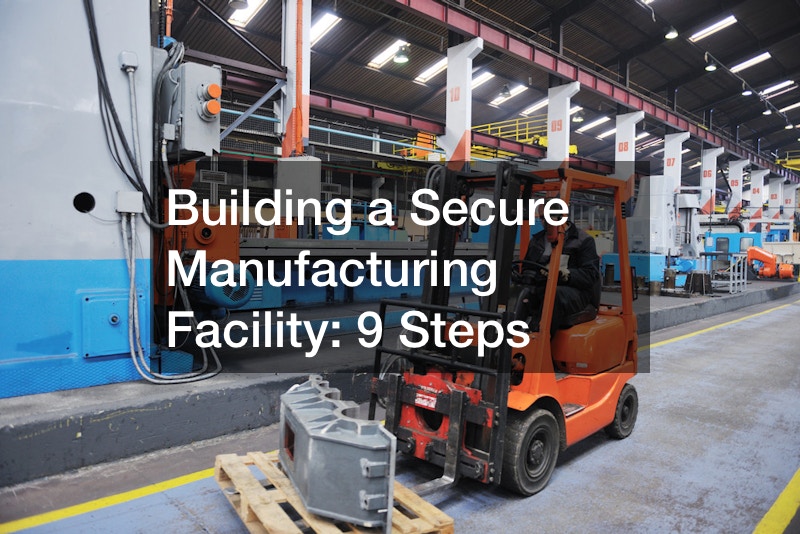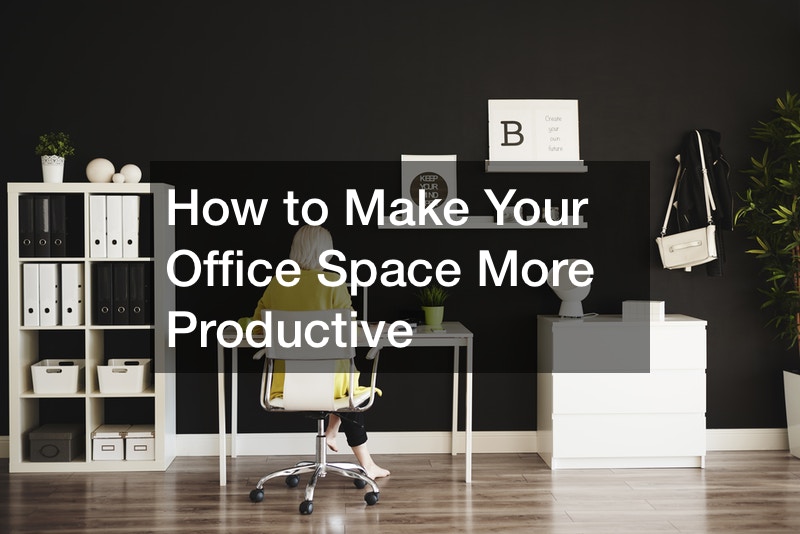
We live in a world that’s becoming increasingly interconnected and filled with technological advances. No matter what industry you’re running a business in, you need to consider security and safety. Simple locked gates and basic cameras are no longer good enough to keep a manufacturing facility secured and protected.
Your business may be housing valuable equipment and sensitive data or private intellectual property, all of which must be kept away from prying eyes and thieving hands. Unless you want a business attorney to knock on your door with complaints about data breaches, there are many steps you have to follow to ensure safety on your premises in every sense of the word.
Here are the essential steps you have to keep in mind when you design and build a manufacturing facility to ensure it’s as secure as possible, discussed briefly so you have all the knowledge you need.
Step 1: Conduct a Security Risk Assessment

First things first, you should run a thorough and lengthy security risk assessment. You need to know the current state of security measures before you can move ahead and implement better ones. You need to be able to accurately identify any vulnerabilities or potential threats that are specific to your company’s industry. Additionally, you have to evaluate the facility’s cyber security and physical security. If there are risks from natural disasters or serious accidents, you need to be aware of them as well. This assessment will take a good deal of time to complete, but cannot be skipped or done half-heartedly. A comprehensive security plan cannot be created with all the necessary information.
Step 2: Design a Secure Layout
The best way to secure manufacturing processes is by having a layout that is well-planned with security in mind. Your facility’s design is crucial because a poor design can lead to many vulnerabilities that you can easily overlook by accident. Work with engineers, security professionals, and engineers to come up with a layout that reduces vulnerabilities. Take into account elements like access control, optimal placement of surveillance cameras, strategic positioning of emergency exits, and secure storage areas for sensitive materials. Additionally, ensure the design incorporates clearly defined pathways for employees and distinct zones to regulate visitor access.
Step 3: Implement Access Control Systems

Ensuring strict control over entry and exit points at your manufacturing facility is crucial for maintaining security. Focus on implementing access control systems that leverage personalized key cards, secure codes, biometric scanners, or other advanced technologies. By doing so, you can restrict access to specific areas based on employees’ respective roles and responsibilities. Furthermore, consider the integration of visitor management systems to effectively monitor and record all entry and exit activities. You really can never be too cautious when it comes to your facility’s security.
Step 4: Install a High-Quality Alarm System
When it comes to truly secure manufacturing practices, an alarm system should not be overlooked merely because they are the most common form of security. As such, it’s absolutely imperative for every manufacturing plant to have an effective alarm system installed. In the event of a break-in, such a system can significantly reduce the risk of theft and other associated problems by promptly notifying your command center and contacting the appropriate authorities. Maintaining effective communication is essential for ensuring security, and a reliable alarm system can effectively transmit alerts throughout the manufacturing plant, enabling swift awareness of any potential danger. This, in turn, facilitates prompt action and allows for the implementation of necessary precautions.
Step 5: Install Video Surveillance
Another critical element that can ensure secure manufacturing is video surveillance. This form of security plays a crucial role in ensuring the protection and security of a manufacturing facility. It’s important to strategically position cameras throughout the facility, ensuring coverage of storage rooms, entry points, various production areas, and outdoor spaces. Additionally, it’s vital to have a camera system that provides high-quality, clear video footage, supports remote monitoring, and has reliable backup storage capabilities. By incorporating video analytics software, you and your security team can further enhance security measures by detecting suspicious activities in real time and promptly alerting security personnel.
Step 6: Establish Intrusion Detection Systems
Intruders can cause great damage to even a really secure manufacturing facility if there’s no way of effectively detecting them and reacting in time. To effectively identify and prevent unauthorized access attempts, it’s essential to implement high-quality and reliable intrusion detection systems. These systems encompass a range of components, such as door or window sensors, motion sensors, glass break detectors, and alarms. When combined with a central monitoring station or dedicated security personnel, these systems enable swift responses to potential breaches, thereby minimizing the risk of theft or property damage. By deploying intrusion detection systems, you can enhance the overall security measures of your facility.
Step 7: Implement Cybersecurity Measures

Physical security measures are definitely very important, but you shouldn’t underestimate the dangers of the cyber world. Thanks to the creativity of those with ill intentions, manufacturing facilities face growing risks from cyber threats. To ensure the protection of your facility’s network and sensitive data, it’s essential to establish strong cybersecurity measures. Take advantage of protective elements such as firewalls, the latest intrusion prevention systems, and encryption protocols to fortify your systems against unauthorized access and potential data breaches. By implementing robust cybersecurity measures, you can effectively safeguard your facility and its critical assets.
Step 8: Update Equipment and Software
The key to secure manufacturing is knowing about every possible threat you face, even if it seems like only a distant worry. Addressing internal threats in a timely manner is crucial for you to maintain a secure manufacturing facility. It’s essential to avoid having outdated equipment and software, as these can pose risks to your employees’ safety. As the boss or owner, it’s your duty to regularly update your security software, technology, and equipment to enhance the overall well-being of your facility. Since threats are constantly evolving, neglecting the tools used for security can have severe consequences. For example, it is important to ensure that equipment in security command rooms is always in good condition. Additionally, consider providing your security teams with sturdy and ergonomic furniture to ensure their comfort and enable effective monitoring.
Step 9: Remember Industrial Health and Safety
Your security measures should not only prioritize the protection of your manufacturing facility but also contribute to the health and safety of your workers. During your risk assessment, consider the specific nature of your production processes. If you handle fire, hazardous chemicals, or combustible materials, it is essential to reinforce your plant accordingly to mitigate the risk of accidents.
This may involve implementing sensitive fire safety systems, conducting regular fire drills, and installing blast walls, among other measures. To maintain a safe environment, consider hiring a commercial dumpster rental service to remove materials that should not be present on your premises.
Additionally, ensure wastewater treatment to prevent any negative impact on the health of your employees through the consumption of contaminated water. If power tools or heavy equipment and machinery are used, it is imperative that your staff has appropriate protective equipment, receives safety training, and follows necessary safety protocols to prevent accidents.
Furthermore, it may be necessary to work with professional commercial plumbing and commercial roofing services to ensure the overall safety and security of your building. This is essential to prevent issues such as roof collapses or extreme temperature conditions that could jeopardize the well-being of your workers.
Step 10: Conduct Regular Maintenance
In addition to setting up security measures, you also need to have regular maintenance checks. Not only should you take care to maintain the software and hardware of your facility, but the other parts of it as well. You need to do at least one septic inspection every six months to make sure everything is working as it should. Also, you should hire HVAC contractors with enough relevant experience to take care of your systems.
As for the outside, you should consider the facility’s industrial concrete needs. It may seem like just an aesthetic element, but taking care of the exterior is important for safety as well. If you find that there is damage to your facility’s asphalt, consider hiring an asphalt maintenance professional to help you take care of it.
Step 11: Secure Perimeter and Outdoor Areas
Intruders can come from literally anywhere, so to ensure secure manufacturing, you need to be prepared and ready to react appropriately. Establishing a secure facility goes beyond securing the building alone; it involves paying attention to the perimeter and outdoor areas as well. To enhance your security efforts, you should install robust fencing, high-quality access gates, and effective security lighting around the entire facility. Additionally, consider integrating advanced technologies like perimeter intrusion detection systems or video analytics to actively monitor and identify any unauthorized access attempts.
Step 12: Train Employees on Security Protocols

The role of your employees in maintaining a secure manufacturing facility is of the utmost importance. It’s essential to provide comprehensive security training for all staff members, emphasizing the significance of adhering to protocols and reporting any suspicious activities. Educate your employees about the gravity of cybersecurity risks, critical social engineering techniques, and the best practices for safeguarding sensitive information. Conduct regular refresher courses to keep security knowledge up to date and foster a culture of security within the organization. By prioritizing employee security education and instilling a strong sense of vigilance, you can significantly enhance the overall security of your manufacturing facility.
Step 13: Implement Device Profiling
This is a security measurement that most companies tend to overlook. But the thing is, most of your workers have their own mobile devices, phones, or tablets that they carry around with them while at work. You need to make sure this doesn’t allow an opening for a security risk by keeping tabs on them. Of course, you can’t invade their privacy, so do this with as little interruption as possible. You can monitor, authenticate, and control all users or applications that connect to your network without being intrusive.
Step 14: Develop an Incident Response Plan
One of the best ways to ensure secure manufacturing in all ways is by preparing for any potential security incidents. Your security team as well as your standard employees need to know what to do if something goes wrong. To ensure preparedness and efficient responses to breaches or emergencies, it’s crucial to define clear roles and responsibilities within your facility. Establish effective communication channels to facilitate timely and accurate information sharing. Outline detailed steps to be taken in the event of a breach or emergency, providing employees with a comprehensive plan. Regularly conduct drills and simulations to test the effectiveness of the plan and train employees on proper response procedures.
Step 15: Conduct Regular Security Audits
In addition to regular maintenance checks and software updates, you also need to conduct regular security audits. Not running regular audits can lead to you missing crucial errors. You should use a relevant measurement device to ensure your alarm is working accurately, for example. Frequently assess and analyze your security measures to identify any weaknesses or areas that require improvement.
Conduct thorough penetration testing, vulnerability assessments, and security audits to proactively address potential vulnerabilities. You need to stay informed about emerging security technologies and industry best practices and make the necessary updates to your security systems and protocols accordingly. By regularly testing and evaluating your security measures, you can stay one step ahead of potential threats and ensure that your manufacturing facility remains adequately protected.
You need to take a multifaceted and proactive approach to your plans to build a secure manufacturing facility if you want to address digital and physical security risks successfully and efficiently. The steps discussed in this article will guide you in the right way and you can add your own extra steps if necessary. As you come up with your own plan, it’s essential that you work with security professionals that have experience in sorting out these kinds of plans. Going at it alone may be tempting, but you’ll thank yourself later if you work with knowledgeable experts and let them assist you every step of the way.




